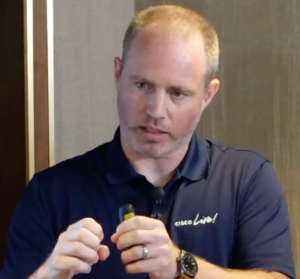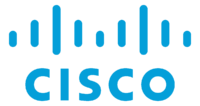|
|
 Cisco Cloud and Compute Presented at Tech Field Day Extra at Cisco Live US 2023 |
This Presentation date is June 7, 2023 at 13:00-15:00.
Presenters: Gerard Sheehan, Moty Cohen, Omar Sultan, Shangxin Du, Tim Szigeti
Delegate Panel: Aaron Conaway, Ed Weadon, Eric Stewart, Evan Mintzer, Jody Lemoine, Rob Coote, Teren Bryson, Zoë Rose
Follow on Twitter using the following hashtags or usernames: #CiscoLive, #TFDx
Cisco Why You Need a CNAPP ASAP!
Watch on YouTube
Watch on Vimeo
Over 750 million new cloud native applications will be developed by 2025. This astronomical rate of application development is enabled by the widespread adoption of cloud native application architectures. However, these microservice-based architectures also massively increase the attack surface and expose applications to new vulnerabilities and threats. To meet these threats, Cisco is launching a new cloud native application protection platform (introduced in the technology keynote on June 6). This session will provide details and demonstrations of this new Cloud Native Application Protection Platform (CNAPP) in action.
In response to the increasing complexity and distribution of applications, traditional security measures are no longer adequate in safeguarding against potential attacks. To address this challenge, a new security approach is required, one that incorporates security measures at every phase of the application development process. Cisco Panoptica recognizes the need for such an approach and has acquired Lightspin technologies to expand its capabilities in mitigating software vulnerabilities, misconfigured infrastructure, and other vulnerabilities. By identifying specific security exposures and rating risks individually, Panoptica’s tool offers remediation steps, including CLI usage. With the ability to contextualize threats and their criticality, the tool effectively filters noise, ensuring better protection against complex attacks. Panoptica emphasizes the importance of making security-conscious development choices, hardening infrastructure, securing entitlements, and continuously monitoring runtime environments. As part of their commitment to cloud-native security adoption, Cisco is providing Panoptica as a free tool for users.
Personnel: Tim Szigeti
Integrating Streaming Telemetry on Cisco NX-OS with Opensource Tooling
Watch on YouTube
Watch on Vimeo
See how to integrate NX-OS with the open source TIG stack, to gain visibility into the state of the network, visualize the data on Grafana, and see how to troubleshoot your network.
Cisco is actively engaged in enhancing programmability, automation, visibility, and telemetry capabilities within the XOS system. Their primary focus revolves around integrating the XOS system with open-source tooling, emphasizing the utilization of APIs and telemetry overview to gather essential data. Two distinct approaches to telemetry are discussed: dial out and dial in, each offering different operational models to cater to customer needs. While the TIG stack, comprising Telegraph, InfluxDB, and Grafana, is commonly employed for visualizing telemetry data, alternative methods for constructing similar dashboards are also explored. The true value of telemetry data lies in its interpretation and its application for DevOps purposes. Use cases for dashboard and telemetry data in daily operations are highlighted, with two examples demonstrating how telemetry data can greatly aid in troubleshooting and issue isolation within a network. Additionally, Grafana, an open-source tool, can establish alerts based on thresholds and state changes, albeit with a steep learning curve for the query aspect.
Personnel: Gerard Sheehan, Shangxin Du
Cisco Routed Optical Networking with Crosswork Hierarchical Controller
Watch on YouTube
Watch on Vimeo
This presentation is an overview of automation solutions for Routed Optical networking, over multiple vendors utilizing Cisco’s Crossword Hierarchical Controller.
Moti serves as the Product Manager for the Hierarchical Crosswork Controller, a crucial component of the comprehensive Crosswork Suite. This suite offers orchestration, automation, and control for multi-layer IP and optical networks. The Crosswork solution streamlines network architecture by reducing layers and protocols, enabling the consolidation of services like IP, OTN, TDM, and PLE onto a single platform. With its ability to provide end-to-end connectivity provisioning and integration with both IP and optical equipment controllers, the Hierarchical Crosswork Controller offers a comprehensive view of the network from IP services down to the optical layer. It also facilitates network visualization, identifies potential points of failure, proximity rule violations, and other fiber and service-related insights to optimize maintenance and performance. The Controller manages various components such as IP gear, optical line systems, rodents, and ZRs, and ensures seamless connectivity across different layers. Troubleshooting involves analyzing information at each layer and reviewing performance history for individual components. The SHQL (Sedona Hierarchical Query language) simplifies complex data queries, allowing users to ask straightforward questions about network performance, while APIs enable customers to integrate their preferred workflow manager into the system.
Personnel: Moty Cohen
Cisco Crosswork Workflow Manager with Omar Sultan
Watch on YouTube
Watch on Vimeo
This session introduces Cisco Crosswork Workflow Manager and its key elements.
In this presentation, Omar Sultan, Director of Product Management for Automation at Cisco, introduces Crosswork Workflow Manager. The goal of the product is to make automation tasks easier by providing a tool that allows users, even non-technical ones, to automate common tasks with a push-button approach. Sultan highlights the challenges of automation adoption and emphasizes the need for workflow solutions that can integrate with multiple tools and systems. He describes the design goals of the product, including reliability, extensibility, and programmability, and explains how the product leverages open-source technologies like Temporal and serverless for workflow management. The presentation also covers the roadmap for Crosswork Workflow Manager, which includes plans for additional adapters, a GUI design studio, change management features, and auto-scaling capabilities. The ultimate vision is to empower customers with autonomy by providing a customizable and user-driven workflow solution. A live demo showcases the capabilities of the product, demonstrating how it can orchestrate tasks across different platforms and provide visibility into the workflow execution. The presentation concludes by highlighting the availability of professional services from Cisco for those who prefer assistance in building and maintaining workflows.
Personnel: Omar Sultan









